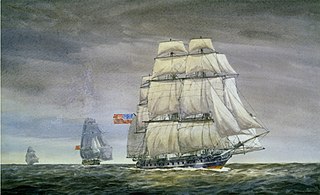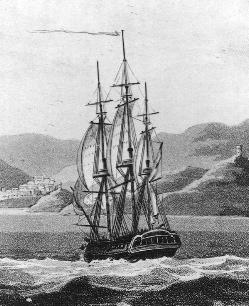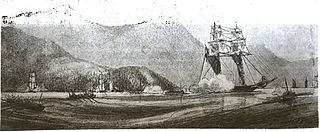
The USS Enterprise was a schooner, built by Henry Spencer at Baltimore, Maryland, in 1799. Her first commander thought that she was too lightly built and that her quarters, in particular, should be bulletproofed. Enterprise was overhauled and rebuilt several times, effectively changing from a twelve-gun schooner to a fourteen-gun topsail schooner and eventually to a brig. Enterprise saw action in the Caribbean, the Mediterranean, and the Caribbean again, capturing numerous prizes. She wrecked in July 1823.
USS Baltimore was a ship of the United States Navy.

The third USS Boston was a 32-gun wooden-hulled, three-masted frigate of the United States Navy. Boston was built by public subscription in Boston under the Act of 30 June 1798. Boston was active during the Quasi-War with France and the First Barbary War. On 12 October 1800, Bostonengaged and captured the French corvette Berceau. Boston was laid up in 1802, and considered not worth repairing at the outbreak of the War of 1812. She was burned at the Washington Naval Yard on 24 August 1814 to prevent her capture by British forces.

USS Adams was a 28-gun (rated) sailing frigate of the United States Navy. She was laid down in 1797 at New York City by John Jackson and William Sheffield and launched on 8 June 1799. Captain Richard Valentine Morris took command of the ship.

USS Philadelphia, a 1240-ton, 36-gun frigate, was the second vessel of the United States Navy to be named for the city of Philadelphia. Originally named City of Philadelphia, she was built in 1798–1799 for the United States government by residents of that city. Funding for her construction was raised by a drive that collected $100,000 in one week, in June 1798. She was designed by Josiah Fox and built by Samuel Humphreys, Nathaniel Hutton and John Delavue. Her carved work was done by William Rush of Philadelphia. She was laid down about November 14, 1798, launched on November 28, 1799, and commissioned on April 5, 1800, with Captain Stephen Decatur, Sr. in command. She was captured by Barbary pirates in Tripoli with William Bainbridge in command. Stephen Decatur led a raid that burned her down, preventing her use by the pirates.

USS Constellation was a nominally rated 38-gun wooden-hulled, three-masted frigate of the United States Navy.
The first USS Eagle, a schooner, was built at Philadelphia, Pennsylvania, in 1798, and commissioned in the Revenue Cutter Service under the command of Captain Hugh G. Campbell, USRCS.
USS Maryland was a sloop-of-war in the United States Navy. She served during the Quasi-War with France.
USS Ganges was a man-of-war in the United States Navy during the Quasi-War with France.

USS Experiment was a schooner in the United States Navy during the Quasi-War with France.

USS Pickering was a brig, the 1st brig built for the UCRC Service, in the United States Revenue Cutter Service and then the United States Navy during the Quasi-War with France. She was named for Timothy Pickering, then the Secretary of State.
The first USS George Washington was a frigate in the United States Navy. She was named after United States Founding Father and President George Washington.
The second USS Delaware was a ship which served in the United States Navy during Quasi-War with France.
The second USS General Greene was a frigate in the United States Navy during the Quasi-War with France.
USS Merrimack, was a ship launched by an Association of Newburyport Shipwrights and presented to the Navy in 1798. She was the first ship of the Navy to be named for the Merrimack River. She saw action in the Quasi-War.
USS Portsmouth was constructed for the United States Navy in 1798 by master shipbuilder James Hackett to a design of Josiah Fox at what is now Badger's Island in Kittery, Maine, directly across the Piscataqua River from Portsmouth, New Hampshire. She was built with funds contributed by the citizens of Portsmouth.
USS Richmond was a brig purchased for the US Navy in 1798 by the citizens of Richmond, Petersburg, Manchester and Norfolk, Virginia, while being built at Norfolk as Augusta for a Mr. Myers. Renamed Richmond, she was fitted out in the fall of that year and in December stood out from Hampton Roads for the Caribbean with Captain Samuel Barron in command for service in the Quasi-War with France.
The first USS Patapsco was a sloop in the United States Navy.
The Connecticut was a sailing frigate built by Seth Overton at Chatham, Conn. and launched 6 June 1799 at Middletown, Conn. During outfitting, probably on or just before 7 July she foundered. She was refloated. She sailed 15 Oct. 1799 under the command of Captain Moses Tryon for the Guadaloupe Station, arriving off Puerto Rico on 28 October. She cruised in the West Indies for a year during the Quasi-War with France, protecting American commerce from French privateers. Connecticut's successful career was highlighted by the capture of four privateers and the recapture of seven American merchantmen. On 7 November, 1799 she recaptured schooner "Hannah" captured 72 hours earlier. On 8 December she recaptured brig "Penelope" captured by French privateer "Fleur de Mair" on 3 December. On 28 December she engages captured American schooner "Polly" that is then run ashore a Legue west of Point Chateaux. After a fight with the prize crew, who were on shore, it was found to be impossible to refloat her and she was burned. On 30 December she captured off Point Petre French privateer brig "Conqueror of Italy", the most successful privateer operating out of Guadeloupe having captured 200 American merchant ships. "Conquest of Italy" was put in service as a tender for USS Constellation. On 15 January, 1800 She fired upon a privateer but it found shelter by a fort on Demerara, later that day she chased a ship ashore at Deseada which bilged and sank. On 2 April she stopped and detained ex-American schooner "Commerce" that had been captured by a privateer, condemned by Court at Point Peter and sold to a Dane. Capt. Tryon thought her papers were not "regular" and sent her to [[St. Kitts] for evaluation, where she was released. On 28 April, with USS Richmond, she recaptured Thomas Chalkley. On 1 June, she captured privateer schooner "Le Piege" off Descada, and on 3 July recaptured brig "Martha and Mary" on the north side of St. Kitts. On 5 June, captured privateer schooner "La Unite". On 17 June, recaptured a schooner off Guadalupe. On 15 July, with USS Philadelphia, captured French Letter of Marque ketch "Le Chouchou". Arrived at New London, Conn., 18 Oct. 1800. Capt. Richard Derby was ordered to replace Capt. Tryon on 1 November. In a letter dated 20 February to Josiah Parker, chairman of the Committee on Naval Affairs, Navy Secretary Stoddert recommended selling her. Connecticut was sold at New York in 1801 for $19,300.
USRC Diligence was a cutter/schooner operated by the United States Revenue Cutter Service.






